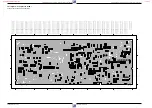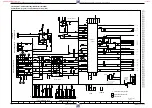
GRUNDIG Service-Technik
2 - 7
Beschreibungen / Descriptions
verzögern und es mit dem Signal aus dem unverzögernden Zweig,
CF873-(3), zu addieren. Diese beiden Signalwege zusammen bilden
das “Kammfilter” zur Übersprechkompensation.
Bei SECAM-Betrieb wird das Kammfilter umgangen.
Anschließend durchläuft das Signal einen Wiedergabeverstärker mit
Farbkiller. In der nachfolgenden "Y-C-MIX-Stufe" wird es zu dem intern
zugeführten Y-Signal addiert und anschließend in der FBC-Stufe
(feedback clamp) auf Synchronboden geklemmt.
Trägeraufbereitung (PAL/NTSC)
– Aufnahme (PAL)
Zur Trägeraufbereitung verwendet man einen spannungsgesteuerten
Quarzoszillator (VXO) im IC7051, dessen Oszillatorfrequenz
(4,43361MHz) von dem an den Pins 18 und 19 angeschlossenen
Quarz (Q1601) bestimmt wird. Der REC-APC-Detektor vergleicht die
Phase des ankommenden Senderbursts mit der des VXO und regelt
diesen nach. Diese an IC7051-(17) stehende Regelspannung wird mit
C2048, R3052 und C2047 geglättet. Des weiteren verwendet man
einen im IC7051 integrierten Oszillator (321xfH VCO). Dieser wird von
der Synchronfrequenz geregelt. Der VCO schwingt auf einem Vielfa-
chen der Zeilenfrequenz (321f
H
). Das entspricht einer Frequenz von
5,015625MHz. In einem Abwärtszähler (1/2) teilt man diese Frequenz
zunächst durch 2 und dann in einem 4-Phasenschieber durch 4 und
führt sie dem Hilfsmischer (SUB CONV) zu. Hier wird sie mit der
Oszillatorfrequenz des VXO (4,43361MHz) gemischt. Dabei entsteht
der Hilfsträger von 5,06MHz. Dieser durchläuft einen internen 5,06MHz-
Bandpaß und wird anschließend dem Hauptmischer (MAIN CONV)
zugeführt.
– Wiedergabe (NTSC/PAL)
Bei Wiedergabe verwendet man den frei auf der Quarzfrequenz
(Q1601- 4,43361MHz) schwingenden XO-Quarzoszillator als Refe-
renz und den VCO-Oszillator. Der VCO wird jetzt, nach erfolgter
Rückmischung des Chromasignals von 627kHz (PAL) bzw. 629kHz
(NTSC) auf 4,43MHz-Hilfsträgerfrequenz, vom Burst des wiedergege-
benen F-Signals synchronisiert. Die Pb-APC-Stufe erzeugt die Regel-
spannung für den VCO und vergleicht dabei die Phase des Quarzos-
zillators mit der Phase des rückgemischten 4,43MHz-Bursts. Die
Zeitkonstante des Siebgliedes an IC7051-(24) ergibt sich aus C2057,
C2058 und R3055. Im Abwärtszähler (1/2) und im 4-Phasenschieber
(1/4) teilt man diese Frequenz durch 8 und führt sie dem Hilfsmischer
(SUB CONV) zu. Hier wird sie mit der Oszillatorfrequenz des XO
gemischt. Dabei entsteht unter anderem der Hilfsträger von 5,06MHz.
Dieser wird über das interne Bandfilter dem Hauptmischer (MAIN
CONV) zugeführt.
signal from the non-delaying branch CF873-(3). These two paths form
the so-called "comb filter" for cross-talk compensation.
In SECAM mode the comb filter is bypassed.
Subsequently, the signal is taken to a playback amplifier with colour
killer. In the "Y-C-MIX" stage which follows it is added to the internally
fed in Y-signal and subsequently, in the FBC-stage (feedback clamp),
it is clamped to sync level.
Carrier Preparation (PAL/NTSC)
– Record (PAL)
For carrier preparation use is made of a voltage-controlled quartz
oscillator (VXO) in IC7051 the oscillating frequency (4.43361MHz) of
which is determined by the quartz (Q1601) connected to pins 18 and
19. The REC-APC detector compares the phase of the transmitted
burst with that of the VXO and controls the latter accordingly. This
control voltage is provided on IC7051-(17) and is smoothed by C2048,
R3052 and C2047. In addition, an oscillator (321xfH VCO) is used
which is integrated in IC7051 and controlled by the synchronizing
frequency. The VCO oscillates at a multiple of the line frequency
(321f
H
) which corresponds to a frequency of 5.015625MHz. This
frequency is divided first by 2 in a down counter (1/2) and then by 4 in
a 4-phase shifter. Subsequently, it is fed to the sub-converter (SUB
CONV) where it is mixed with the VXO oscillator frequency
(4.43361MHz). The result is the subcarrier frequency of 5.06MHz. The
subcarrier passes through an internal 5.06MHz bandpass and is then
fed to the main converter (MAIN CONV).
– Playback (NTSC/PAL)
On playback use is made of the quartz frequency (Q1601 - 4.43361MHz)
of the free running XO quartz oscillator as a reference, and the VCO
oscillator. After reconversion of the chroma signal from 627kHz (PAL)
or 629kHz (NTSC) to the 4.43MHz subcarrier frequency the VCO is
now synchronised by the burst of the played back chroma signal. The
Pb-APC stage generates the control voltage for the VCO comparing
the phase of the quartz oscillator with the phase of the reconverted 4.43
MHz burst. The time constant of the filter circuit which is connected to
IC7051-(24) is determined by C2057, C2058 and R3055. In the down
counter (1/2) and the 4-phase shifter (1/4), the frequency is divided by
8 and fed to the sub-converter (SUB CONV) where it is mixed with the
XO oscillator frequency. The result is, among others, the subcarrier
frequency of 5.06MHz. The subcarrier is supplied via an internal
bandpass filter to the main converter (MAIN CONV).
2.4 Chassisplatte – Standard-Ton /
Audio Linear (AL)
Funktionsübersicht
Die bei Aufnahme dem Standard-Ton-Schaltungsteil zugeführten NF-
Signale gelangen zum Aufnahmeeingang des IC7601 und werden
anschließend für die Längspuraufzeichnung aufbereitet.
Bei Wiedergabe wird das NF-Signal vom AW-Kopf abgenommen,
verstärkt und dem Modulator sowie der EURO-AV-Buchse zugeführt.
2.4.1 Aufnahme
Das NF-Signal von der Empfangseinheit (AFV) erreicht über Pin 2 den
Schalt-IC7551 im "Video/Chroma, In/Out"-Schaltungsteil und das von
der EURO-AV-Buchse (SCART1) über Pin 1. Entsprechend der Be-
triebsart wird das Eingangssignal über das Steuersignal "ESPBH" an
Pin 10 ausgewählt und steht an Pin 15 zur weiteren Verarbeitung zur
Verfügung (AMLP).
Das ausgewählte NF-Signal gelangt über IC7601-(11) und einer
Aussteuerungsautomatik (ALC-Automatic Level Control) an einen
linearen Verstärker (AMP). Das NF-Signal erreicht über IC7601-(13),
C2611, R3612, R3613 sowie IC7601-(14) den integrierten Aufnahme-
Entzerrerverstärker (AMP). An Pin 17 verläßt es den IC7601. Das NF-
Signal wird am Knotenpunkt R3617 / R3618 zum Aufsprechstrom
addiert und anschließend über Steckerkontakt F8-7 dem AW-Kopf
zugeführt. Das andere Ende des AW-Kopfes liegt über F8-5, R3600
und IC7601-(2) an Masse. Die Vormagnetisierungs-Spannung ist mit
R3618 (BIAS) einstellbar.
Für die Funktion "LP" wird die Umschaltung der Aufnahme-Entzerrung
mit den Schaltern EP CTL und LP CTL im IC7601 durchgeführt.
2.4 Family Board – Standard Sound /
Audio Linear (AL)
Function Overview
On record, the AF signals fed into the Standard Sound Circuit Stage
are supplied to the record input of IC7601 and are afterwards prepared
for longitudinal track recording.
On playback the AF signal obtained from the R/P head is amplified and
then fed to the Modulator and the EURO-AV-socket.
2.4.1 Record
The AF-signal from the frontend(AFV) is passed via Pin 2 to the switch
IC7551 in the "Video/Chroma, In/Out" circuit stage and the signal from
the EURO-AV-socket (SCART1) is fed in via Pin 1. Dependent on the
operating mode, the input signal is selected via the control signal
"ESPBH" at Pin 10 and is applied to Pin 15 for further processing
(AMLP).
The selected AF signal is fed via IC7601-(11) and an automatic level
control stage (ALC) to a linear amplifier (AMP). The AF signal is taken
from IC7601-(13) via C2611, R3612, R3613 and IC7601-(14) to the
integrated record equalizing amplifier (AMP). It leaves the IC7601 on
pin 17. The AF signal is added to the record bias current at the junction
R3617 / R3618 and passed on via the plug contact F8-7 to the R/P-
head. The other end of the R/P-head is connected to chassis via F8-5,
R3600 and IC7601-(2). The record bias voltage is adjustable with
R3618 (BIAS).
For the "LP" function, switchover of the record equalizing circuit is
carried out by the switches EP CTL and LP CTL in IC7601.
www.freeservicemanuals.info
It`s Free
















































